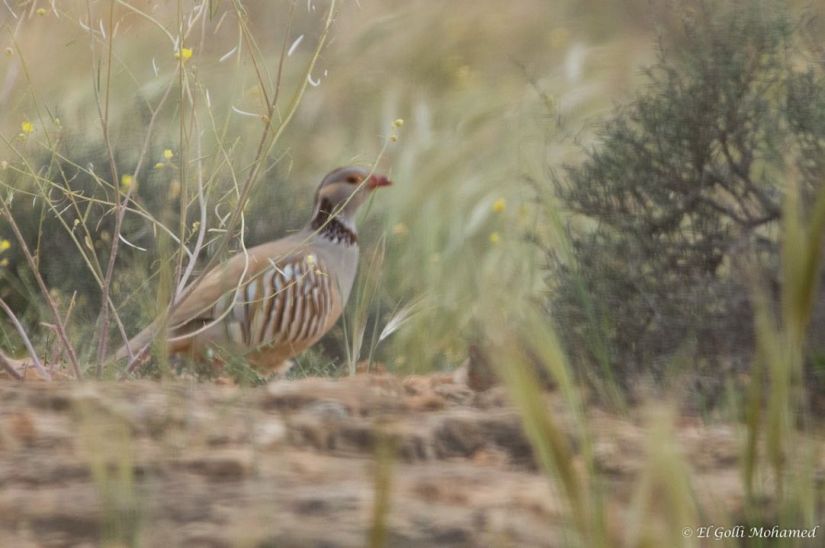Report on Birding Trip to Tunisia
March 2018 (R. Falkner, U.K)
Tunisia – March 2018
Introduction
This week’s trip was organised by Yassine Daoud. He had been recommended to me by Mohamed-Omar Elgoli whose website “Birding in Tunisia”, I had found on Facebook. There are very few birders in Tunisia. But Yassine is in reality a general Tunisian tour guide who has an extraordinary gift with languages (apparently he speaks Russian, German, English and Italian) and good knowledge of Roman and European history, which he was only too keen to impart. He has a passing interest in birds but is not knowledgeable or particularly enthusiastic about bird watching. Luckily he had arranged for Mohamed-Omar to join us for the whole trip. It is Mohamed-Omar who knows the good birding spots, and what might be found where and when.
Mohamed-Omar Elgolli is a professor of Civil Engineering at Tunis University and recognised throughout Tunisia as one of the few good birders in Tunisia, and probably the best bird photographer in the country. Many of the birds seen on the trip, were photographed by Mohamed at the time and, in some cases, only positively identified as a consequence of scrutinising his photos. Photos in this report annotated “EGM” were taken by him.
Tunis Air
I travelled economy class on Tunis Air who managed to delay both my outbound, and inbound flights by around 6 hours each – on both occasions the aircraft took off from Tunis and had to return owing to a technical fault. My delayed outbound flight to Tunis meant that I got to sleep at 3.00am on Sunday, and had to get up at 6.30am in time to be picked up by Yassine, Mohamed-Omar and our driver also called Mohamed.
Day 1. Sunday 18th March – Zaghouan National Park
The four of us set off from my hotel in Tunis at 7.00am for Zaghouan, spotting on the way, a colony of Lesser Kestrels nesting and displaying on the very well preserved Roman aqueduct alongside the road. Here too were a few Spotless Starlings, many Spanish Sparrows and Hoopoe. Male White Storks were nest building on top of telegraph poles.
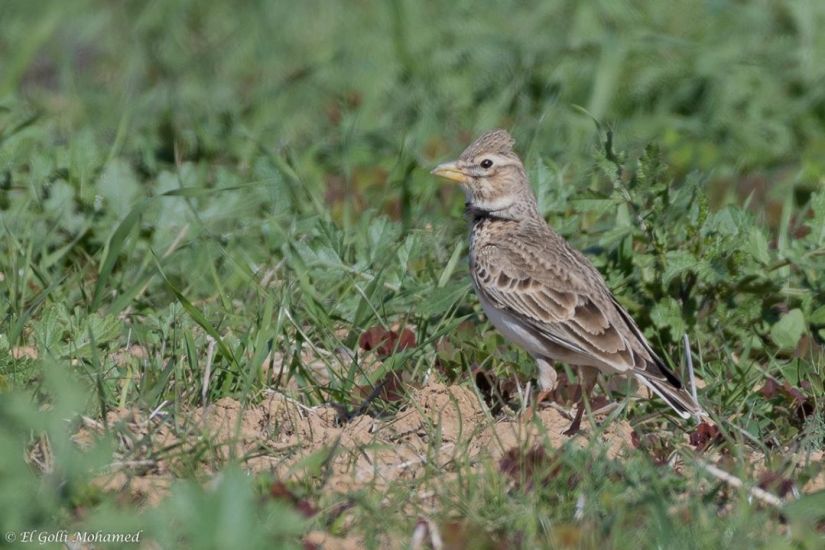
Calandra Lark (EGM)
We diverted to some open farmland near a large saltpan lake, where Mohamed knew that we might find a variety of larks. Here we found Sky, Crested and my first Calandra Lark, as well as Corn Bunting, Long-legged Buzzard and Marsh Harrier. There were also a very large group of Golden Plover on the saltpan.
Sunday turned out to be the first day of the spring half term holidays, so Zaghouan Park proved to be overcrowded with picnickers and local tourists visiting the Temple of Neptune, the source of water for the ancient city of Carthage, carried along the 117 kms of Roman aqueduct, parts of which we had seen earlier. Yassine took me round the Temple of Neptune, but this too was crowded and very noisy with young day-trippers.
The only interesting birds we found in the Park were African Blue Tit (ssp ultramarinus), Yellow Wagtail (ssp Iberia) Common Crossbil, Serin, Southern Grey ( or Iberian) Shrike and Booted Eagle. Mohamed had expected more especially raptors.
We had a sandwich lunch beside the mountain, but I was appalled at the amount of plastic rubbish and discarded tins everywhere. Throughout our trip, even in the wilds of the Sahara, we found discarded rubbish and plastic everywhere: and outside every village and town we came across huge areas of fly-tipping. It is very sad, an appalling reflection on the country, and makes for very uncomfortable birding.
After lunch we drove to two artificial dams – the first held a surprising variety of waterbirds. We quickly identified Pochard, Ferruginous Duck, Tufted Duck, and my first White-headed Duck (we found about seven males and three females IOUN Red list = Endangered). We also saw Black-necked and Little Grebe, Common Snipe, Little Ringed Plover and Green Sandpiper. It was quite windy but not that cold to begin with. Another similar lake produced nothing new, so we headed off to our hotel at Hammamet.
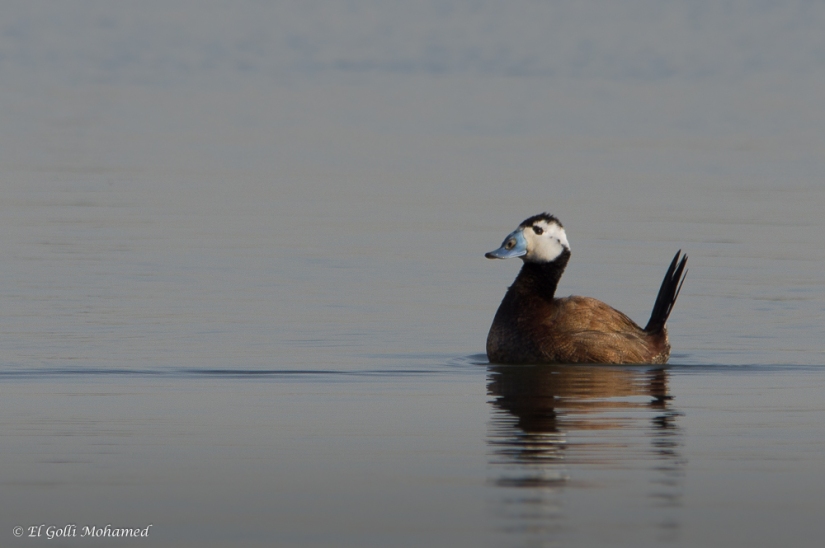
White-headed Duck (EGM)
Day 2. Monday 19th March –Hammamet to Thyna
We arrived at the wadi Sod at about 9.00am, hoping for a possible sighting of Little Crake, but despite careful checking we were unable to find it. We were however very lucky to see a single Marble Teal (IOUN Red list = Vulnerable) and added Shelduck, Little Stint, Reed Warbler, Common Sandpiper, Greenshank and Avocet to the list.
We then headed off to the industrial salt works of Thyna. Here Mohamed knew the gate guard who allowed us entry to the huge area of salt evaporation ponds. However overnight rain showers had made all but the main driveways between the ponds impassable owing to very slippery mud. We saw Black-headed, Slender-billed and Yellow-legged Gulls and the Baltic (ssp of Lesser Black-backed) Gull and a small group of Caspian Terns. There were huge numbers of Greater Flamingos with a few Spoonbills dotted in between, but not much else.
As our birding range at the salt works was limited, we decided to try out a disused sewerage outflow south of Sfax. Although yet another shore area destroyed by fly-tipping of smashed cars, waste building material and general trash, the inter-tidal zone did hold a lot of waterbirds, including Shoveller, Pintail, Wigeon, as well as Kingfisher, Redshank and Greenshank. We saw the sun set, and then headed back to Sfax, and spent the night at Yassine’s home, a well-appointed six bedroomed house. His wife Danni (a lawyer and university lecturer in Human Rights) had prepared us a huge supper of many local Tunisian traditional dishes and delicacies.
Day 3. Tuesday 20th March – B.H National Park
We left Sfax at about 7.30am and headed out into the country towards B.H National Park, passing miles and miles of olive groves. On the way we stopped off at the few rough grazing fields to seek warblers in the scrub bushes. Sardinian and Chiffchaff Warblers were much in evidence and we found a pair of Tristram’s Warblers.
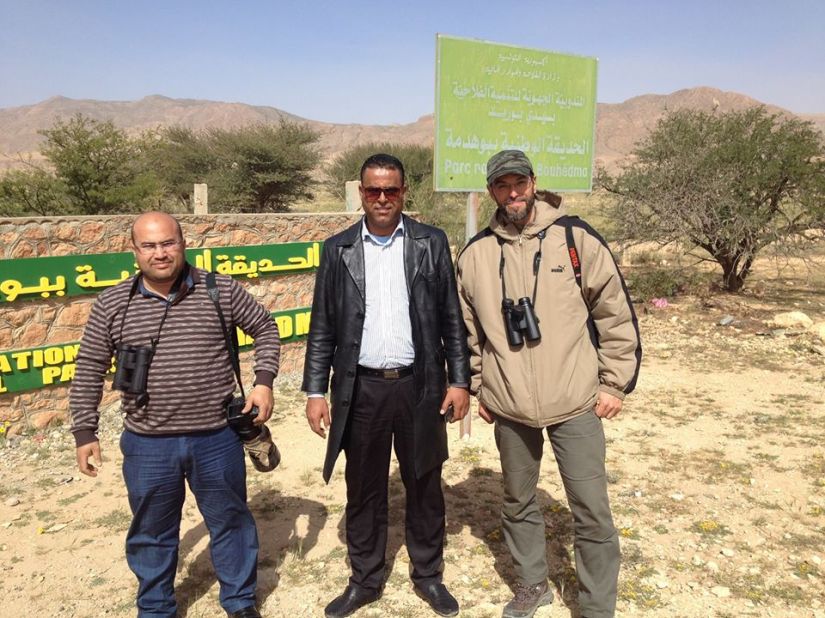
The Team – Yassine, Mohamed the driver, and Mohamed-Omar
Arriving at about 10.30am at the park entrance, we soon found Fulvous Babblers (now renamed Fulvous Chatterers), Barbary Partridge and my first Spectacled Warbler, duly confirmed by a good photo taken by Mohamed with his 700mm lens. At the park’s HQ, Yassine arranged for us to have a park guide take us on the 2.5 km walk to a spring in the hills. It had become very windy and few birds could be seen and, if seen, did not stay around long! We did however have a great sighting of my first Western Orphean Warbler (again confirmed by Mohamed’s good photos) as well as an Eastern Subalpine Warbler.
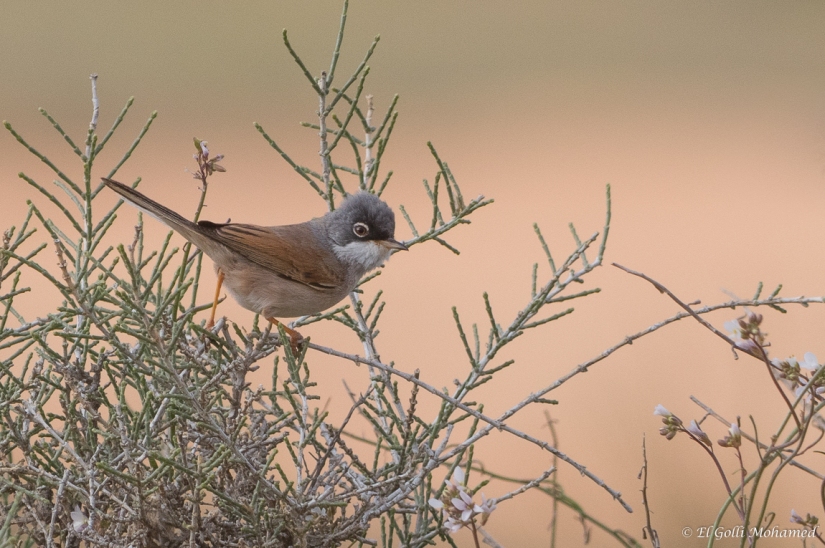
Spectacled Warbler (EGM)
We scoured the shrubs around the spring for Red-necked Nightjar – apparently they spend the day on the ground in the shade of trees around this area – but we found nothing. On the walk back with the wind behind us, we managed to find Red-rumped, Northern and Black-eared Wheatears (ssp melanoleuca) and Common Redstart. Outside the park we spotted a solitary Alpine Swift flying low and close, and a few Lesser Short-toed Larks in a group.
We had a late sandwich lunch at a small village close to the park, while sheltering in a disused shop to keep out of the wind! We then drove from the park up over high stony plains, where we came across twelve Dotterel ( my first) and a variety of small larks including Crested, Bar-tailed, Thekla, Hoopoe-Larks and one Cream-coloured Courser. The short convex Thekla Lark bill was nicely shown up in Mohamed’s photo of same. I also found a pair of Sandgrouse but were too far away to identify – most probably Black-bellied.
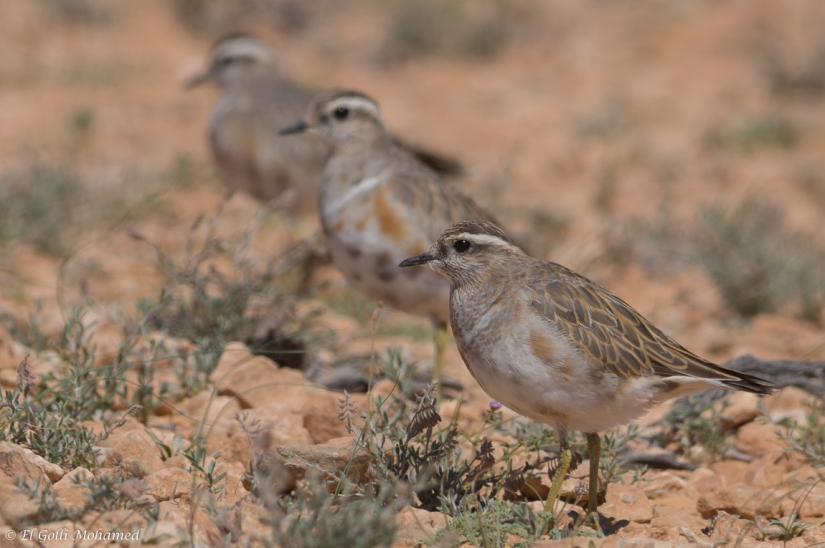
Dotterel (EGM)
As darkness fell we headed to our hotel at Gabes, but our driver overshot the town by some 15 km, and we didn’t get to Amine Gardens Hotel until about 8.00pm.
Day 4. Wednesday 21st March- Roman archaeological site and on to Ksar Ghilane oasis
After breakfast, we drove south to Boughara opposite to the island of Djerba, to the ancient Roman archaeological remains of the Port of Gigthi. We searched in the salt scrub vegetation near the sea, and after half an hour eventually found three Scrub Warblers, another first for me. We also came across a Mourning Wheatear (ssp Magreb) and on the beach Dunlin and Curlew-sandpiper.
From here, we drove to the deserted Berber village build into the caves in the hillside at Chenini. Here, we found House Bunting, Trumpeter Finch and Black Wheatear.
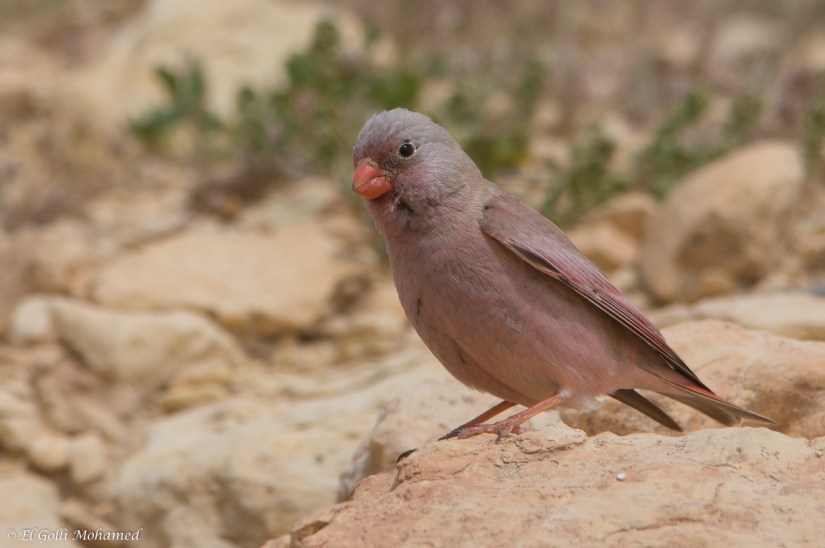
Trumpeter Finch (EGM)
We stopped off at a number of points along the road to the Sahara – the vegetation getting noticeably thinner, but surprisingly we did come across a profusion of low lying flowers, some creating a carpet of spectacular purple. We found a few more Spectacled Warblers and tried for Desert Warblers without success.
We arrived at our desert oasis at Ksar Ghilane quite late just as the sun was setting, but a quick drive round the village before getting to our camp, and stopping where water troughs were located, got me my first White-crowned Black Wheatear. Other birds evident here included Ringed Plover, Yellow Wagtail, Black Kite being chased off by Brown-necked Ravens, and many White Stork wheeling in the air.
My accommodation was an eight bed tent in the Bedouin styl, all to myself, at the misnamed “Camping Le Paradis” within in the oasis. It was very basic with sheets that had seen better days. Loos and showers are some way away from the tents, and very basic with warmish water straight from the oasis spring. That night the temperature plummeted, and my feet froze in bed, despite going to bed fully clothed, and even with two blankets on! Small consolation was listening to a Eurasian Scops Owl calling close by.
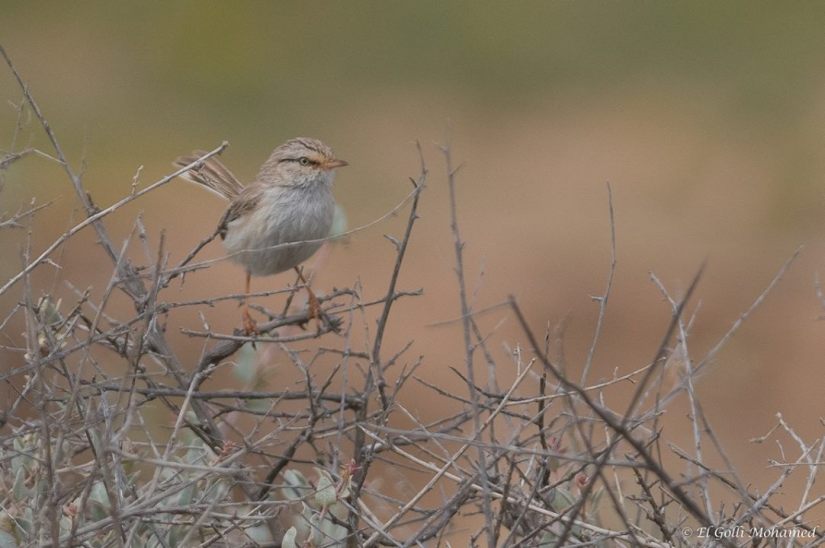
Scrub Warbler (EMG)
Day 5. Thursday 22nd March – Ksar Ghilane Oasis
I rose early at 6.20am and had about an hour’s birding on my own. There were masses of Chiffchaffs everywhere…. I was able to identify Bluethroat (an early migrant according to Mohamed), Blackcap, Common Redstart, Subalpine and Willow Warbler. Other passing migrants included Hoopoe, Moorhen, and Spotted Flycatcher.
After breakfast we set out in the car for a drive in search of the Desert Warbler, according to Mohamed one of the most difficult to find. We did however get a Moltoni’s Warbler and a Western Bonelli’s Warbler (both confirmed by photo) at a puddle by a small spring, both birds were lifers for me.
The oasis attracts many migrating species, but they are time sensitive: we found all the usual hirundinidae, various larks and wheatears, pipits and sparrows and Booted Eagle. Unfortunately we were too early for Rufous-tailed Rock Thrush and Rufous–tailed Scrub Robin, and Atlas Flycatcher had already left for the mountains.
That lunchtime Yassine asked me if I wanted to stay at the oasis for an extra night. He had planned for us to drive all the way up to Cape Bon in the north to watch the raptor migration setting off for Europe. But as I felt I had seen all possible raptors, it seemed sensible to stay and search for the remaining desert birds on my wish list. This despite the continuing cold and high winds and the rather poor accommodation!
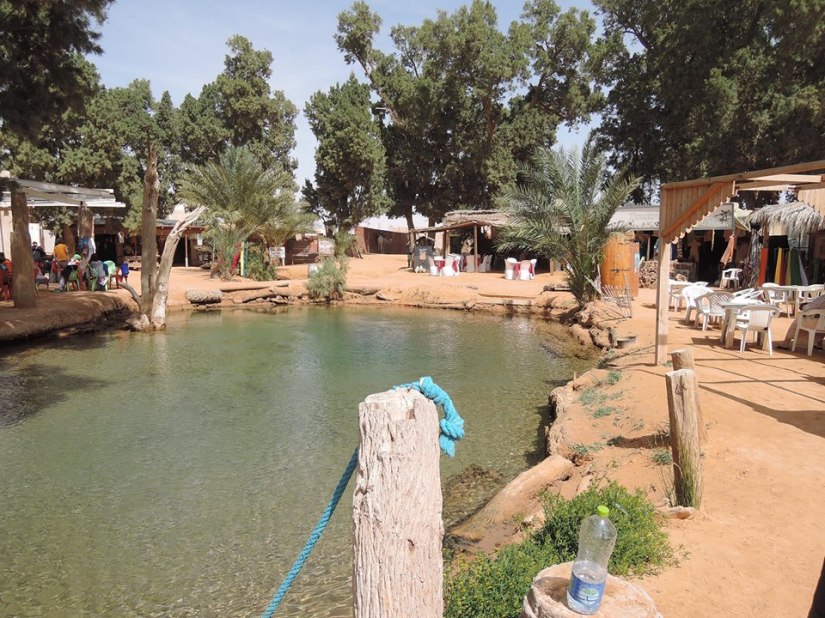
Ksar Ghilane Oasis
After lunch, we spent an hour in search of the Desert Sparrow around the date-palms in the oasis, but to no avail. Mohamed then suggested we take a quad bike ride to the Roman fort of Tisavar some 2 kms west of the oasis. The ancient Roman fort, once a desert outpost on the Limes Tripolitanus defensive line; this was a frontier zone of defence of the Roman Empire, built in the south of what is now Tunisia and the northwest of Libya. It was primarily intended as a protection for the tripolitanian cities of Leptis Magna, Sabratha and Oea. Almost as soon as we arrived at the fort, we were able to find a nesting pair of Desert Sparrows, and Mohamed was able to get great photos of them both.
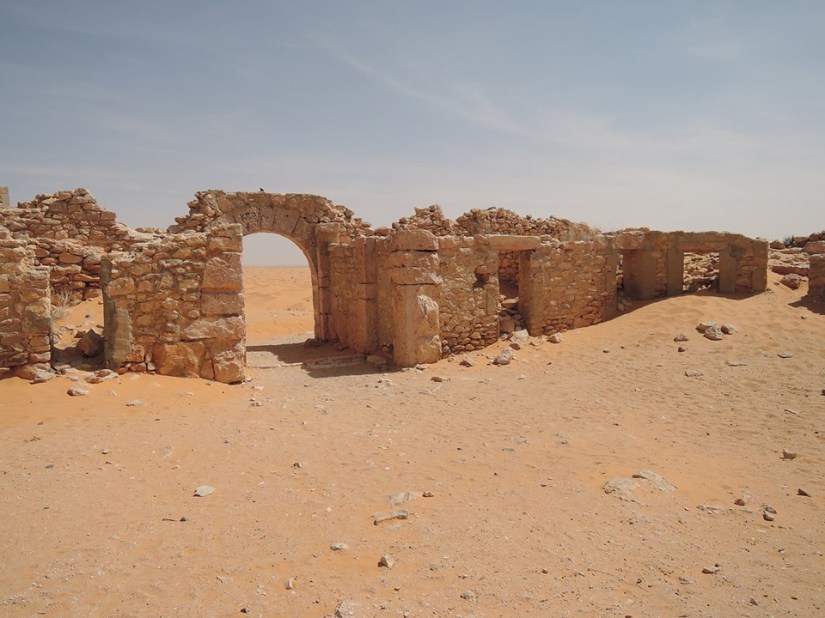
The Roman fort at Ksar Ghilane
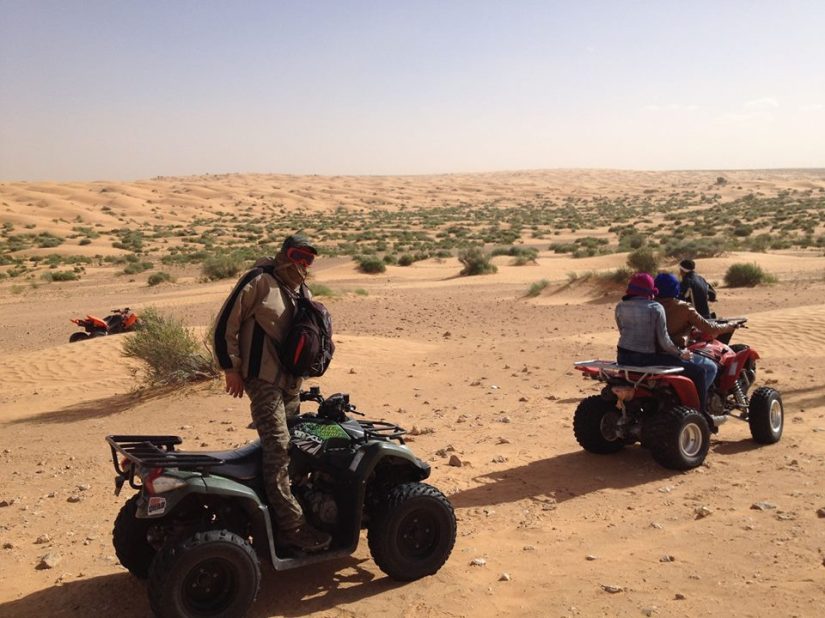
Mohamed Omar on our quad bike.
A further walk around the oasis afterwards, did not reveal anything new: Yassine was great at spotting birds, but had the most annoying habit of not using his binoculars to check a bird out first, but rather he just pointed and shouted, leaving both Mohamed and I to do the identification! More often than not, when he did offer a name, it was wrong.
After supper we tried to listen for Egyptian Nightjar but to no avail. However, I did manage to catch sight of the Eurasian Scops Owl.
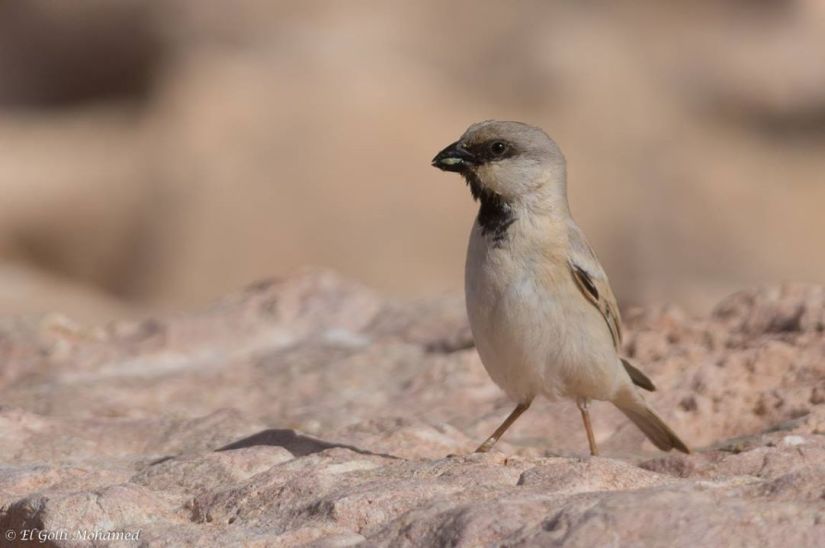
Desert Sparrow (EGM)
Day 6. Friday 25th March- Oasis and long drive back to Sousse
We had just an hour after breakfast to do our last birding at the oasis. We had a five hour drive back up to Sousse where I was to spend the night. We stopped a number of times at various places in the Sahara to look for Desert Warbler, but only found Western Orphean, Sardinian or Spectacled Warblers. We did come across another small party of seven Dotterel as well as Woodchat Shrike, Fulvous Chatterer, and various Wheatears.
I had pointed out the previous evening that I had been rather disappointed not to have seen a Moussier’s Warbler which we should have seen on Day 1 in the mountains. Mohamed took us on the way to a small piece of stony ground where prickly pear cacti was being farmed, and sure enough we found a stunning male calling. The only other bird added to the list was a fleeting sighting of a Black-shouldered Kite by the roadside.
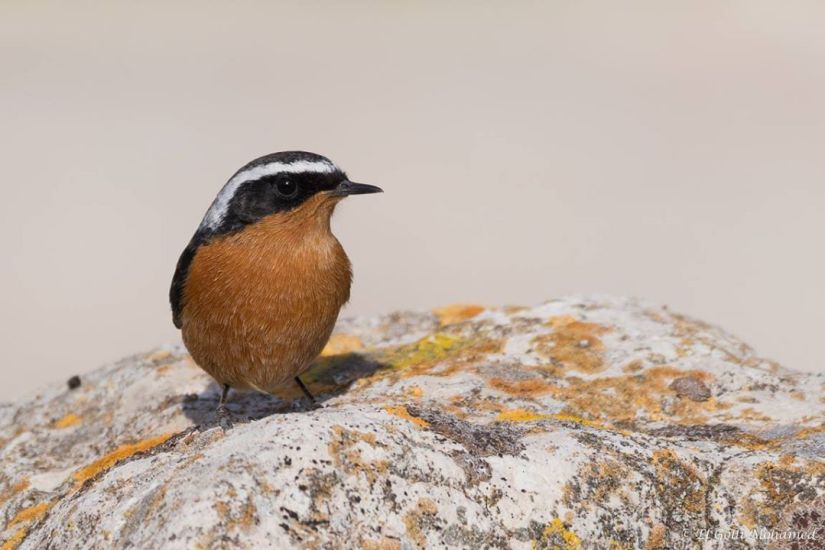
Moussier’s Redstart (EGM)
Day 7. Saturday 26th March – Visit to Carthage and flight home.
At 7.30am we set off for Tunis and there said goodbye to both Mohameds. Before my flight home at 13.45 Yassine took me to Carthage to walk round the (apparently famous) 17th Century Hispanic quarter – owing to some misunderstanding- I had asked him to take me to see the Roman remains at Carthage.
He dropped me off at the airport in good time, but yet again TunisAir managed to take off and after 20 minutes in the air, returned to base with a technical problem, thus causing yet another 6 hour delay!
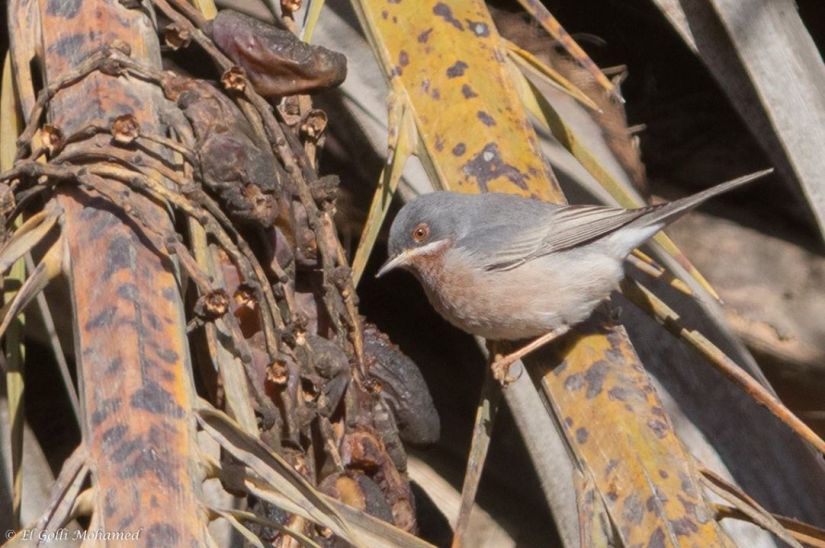
Moltoni’s Warbler in the date palm (EGM)
Summary
A reasonably enjoyable trip but I was not prepared for either the wind or the cold. Having Mohamed-Omar with us was a godsend, as Yassine and myself would not have found and positively identified the variety of birds we did see, especially the desert specialists.
We travelled well over 2000kms in the week:
